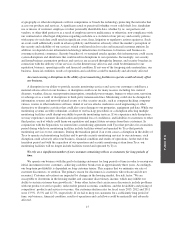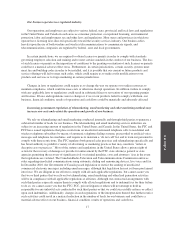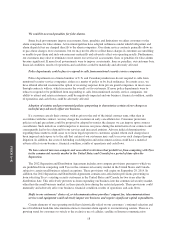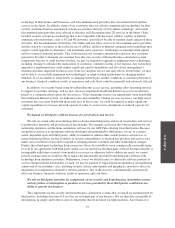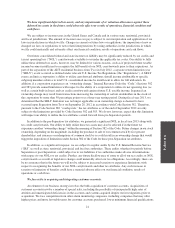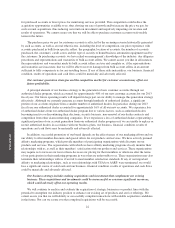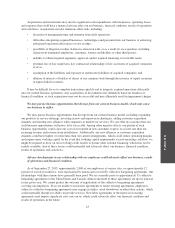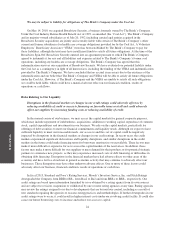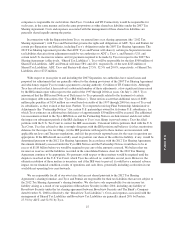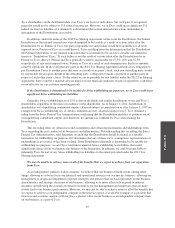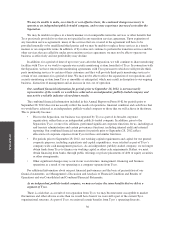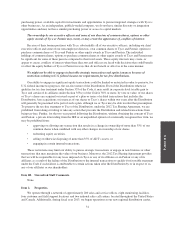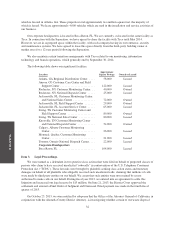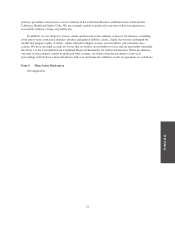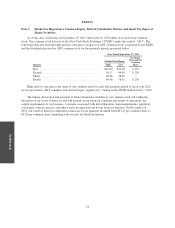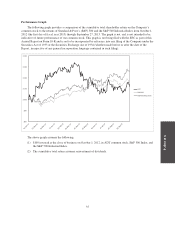ADT 2013 Annual Report Download - page 89
Download and view the complete annual report
Please find page 89 of the 2013 ADT annual report below. You can navigate through the pages in the report by either clicking on the pages listed below, or by using the keyword search tool below to find specific information within the annual report.
FORM 10-K
Covenants in our debt instruments may adversely affect us.
Our revolving credit facility contains customary covenants, including a limit on the ratio of debt to earnings
before interest, taxes, depreciation, and amortization (“EBITDA”), a minimum required ratio of EBITDA to
interest expense and limits on incurrence of liens and subsidiary debt. In addition, the indenture governing our
senior unsecured notes contains customary covenants including limits on liens and sale/leaseback transactions.
Our ability to meet our financial covenants can be affected by events beyond our control, and we cannot
provide assurance that we will meet those tests. A breach of any of these covenants could result in a default under
our revolving credit facility or our indenture. Upon the occurrence of an event of default under our revolving
credit facility or our indenture, the lenders or trustees could elect to declare all amounts outstanding thereunder to
be immediately due and payable and, in the case of credit facility lenders, terminate all commitments to extend
further credit. If the lenders or trustees accelerate the repayment of borrowings, we cannot provide assurance that
we will have sufficient assets to repay our revolving credit facility and our other indebtedness. Furthermore,
acceleration of any obligation under any of our material debt instruments will permit the holders of our other
material debt to accelerate their obligations, which could have a material adverse effect on our financial
condition. See Item 7. Management’s Discussion and Analysis of Financial Condition and Results of Operations.
We may continue to increase our debt or raise additional capital in the future, which could affect our
financial health and may decrease our profitability.
We may continue to increase our debt or raise additional capital in the future, subject to restrictions in our
revolving credit facility and indenture and any debt agreements covering debt incurred subsequent to the date of
this report. If our cash flow from operations is less than we anticipate, or if our cash requirements are more than
we expect, we may require more financing. However, debt or equity financing may not be available to us on
terms acceptable to us, if at all. If we incur additional debt or raise equity through the issuance of additional
capital stock, the terms of the debt or our capital stock issued may give the holders rights, preferences and
privileges senior to those of holders of our common stock, particularly in the event of liquidation. The terms of
the debt may also impose additional and more stringent restrictions on our operations than we currently have. If
we raise funds through the issuance of additional equity, your percentage ownership in us would decline. If we
are unable to raise additional capital when needed, it could affect our financial health. Also, regardless of the
terms of our debt or equity financing, the amount of our stock that we can issue may be limited because the
issuance of our stock may cause the distribution of ADT common shares by Tyco to its shareholders (the
“Distribution”) to be a taxable event for Tyco under Section 355(e) of the Code, and under the tax sharing
agreement entered into in conjunction with the Separation, we could be required to indemnify Tyco for that tax.
See “Risk Factors-Risks Relating our Separation from Tyco-We might not be able to engage in desirable
strategic transactions and equity issuances because of restrictions relating to U.S. federal income tax
requirements for tax-free distributions.”
Material adverse legal judgments, fines, penalties or settlements could adversely affect our financial
health and prevent us from fulfilling our obligations under our outstanding indebtedness.
We estimate that our available cash, our cash flow from operations and amounts available to us under our
revolving credit facility will be adequate to fund our operations and service our debt over both the short term and
the long term. However, material adverse legal judgments, fines, penalties or settlements arising from litigation
and similar contingencies could require additional funding. If such developments require us to obtain additional
funding, we cannot provide assurance that we will be able to obtain the additional funding that we need on
commercially reasonable terms or at all, which could have a material adverse effect on our financial condition,
results of operations and cash flows. Such an outcome could have important consequences to holders of shares of
our common stock. For example, it could:
• require us to dedicate a substantial portion of our cash flow from operations to payments on our
indebtedness, thereby reducing the availability of our cash flow to fund working capital, capital
expenditures, research and development efforts and other corporate purposes, including dividend payments;
25


